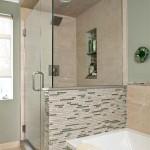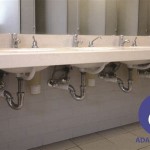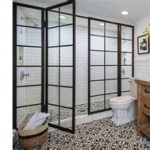Bathroom Vanity Countertops With Double Sinks: A Comprehensive Guide
Selecting a bathroom vanity countertop with double sinks requires careful consideration of several factors, including material, size, style, and budget. This guide aims to provide a comprehensive overview of the various aspects involved in choosing the right double sink vanity countertop to enhance both the functionality and aesthetic appeal of a bathroom.
Double sink vanities have become increasingly popular in master bathrooms and larger family bathrooms. They offer the convenience of simultaneous use, reducing morning congestion and providing ample space for individual grooming routines. The countertop itself plays a crucial role in the overall design and durability of the vanity, serving as a focal point and providing a durable surface for everyday activities.
The decision-making process should begin with an assessment of the bathroom's dimensions. Accurate measurements are essential to ensure the vanity fits properly and allows for comfortable movement within the space. Consideration should also be given to the existing plumbing layout, as relocating plumbing can add significant costs to the project. The next step involves exploring the various countertop materials available and evaluating their respective advantages and disadvantages.
Material Selection Considerations
The material of a bathroom vanity countertop significantly impacts its durability, maintenance requirements, and aesthetic appearance. Some of the most common materials include granite, quartz, marble, solid surface, laminate, and wood. Each material offers a unique combination of properties, influencing its suitability for different bathroom environments and user preferences.
Granite is a natural stone known for its durability and unique patterns. It is highly resistant to heat and scratches, making it an excellent choice for busy bathrooms. However, granite requires sealing to prevent staining and can be more expensive than other options. The natural variations in granite slabs mean that each countertop will be unique.
Quartz, an engineered stone, offers a consistent appearance and is highly durable. It is non-porous, making it resistant to stains and bacteria, and requires minimal maintenance. Quartz is available in a wide range of colors and patterns, offering greater design flexibility. While generally more expensive than laminate, quartz is often considered a worthwhile investment due to its longevity.
Marble is a luxurious natural stone known for its elegant veining. However, it is more porous than granite and quartz, making it susceptible to staining and etching. Marble requires regular sealing and careful cleaning to maintain its appearance. While beautiful, marble might not be the best choice for high-traffic bathrooms or those used by young children.
Solid surface countertops, such as Corian, are made from acrylic or polyester resins. They are non-porous, seamless, and easy to repair. Solid surface countertops can be molded into various shapes and sizes, offering design flexibility. However, they are less resistant to heat and scratches than granite or quartz.
Laminate countertops are a cost-effective option consisting of a plastic laminate bonded to a particleboard core. They are available in a wide range of colors and patterns, mimicking the look of more expensive materials. However, laminate is less durable than other options and can be susceptible to water damage. Laminate is a suitable choice for budget-conscious homeowners but may require replacement sooner than other materials.
Wood countertops, typically made from sealed hardwood, offer a warm and natural aesthetic. However, they require careful sealing and maintenance to prevent water damage. Wood countertops are best suited for bathrooms with good ventilation and low humidity. Regular oiling or sealing is necessary to maintain their appearance and prevent warping or cracking.
Size and Configuration
The size and configuration of a double sink vanity countertop depend on the available space and the desired functionality. Standard double sink vanities range in width from 60 inches to 72 inches, but custom sizes can be accommodated based on specific needs. The depth of the countertop should be sufficient to provide adequate counter space around the sinks.
The placement of the sinks is another important consideration. Sinks can be centered on each side of the vanity, offset to one side, or even installed at different heights to accommodate users of varying heights. The spacing between the sinks should be sufficient to allow comfortable use by two people simultaneously.
Undermount sinks are a popular choice for double sink vanities, as they create a seamless transition between the countertop and the sink. This makes cleaning easier and provides a more modern aesthetic. However, undermount sinks require a solid surface countertop, such as granite, quartz, or solid surface, as laminate and wood countertops are not suitable for this type of installation.
Vessel sinks, which sit on top of the countertop, offer a more dramatic and stylish look. They can be paired with a variety of countertop materials, including laminate and wood. However, vessel sinks require careful consideration of faucet placement to ensure proper water flow and prevent splashing.
Consider the overall height of the vanity. Standard vanity heights are typically 30 to 36 inches, but taller vanities are becoming increasingly popular, particularly for taller individuals. Ensure the chosen height is comfortable for all users of the bathroom.
Style and Aesthetics
The style and aesthetics of a double sink vanity countertop should complement the overall design of the bathroom. Consider the existing color scheme, fixtures, and architectural style when selecting a countertop material and finish. The countertop should enhance the bathroom's visual appeal and create a cohesive and harmonious space.
For a modern bathroom, consider quartz countertops in neutral colors such as white, gray, or black. Clean lines and simple designs are characteristic of modern aesthetics. Undermount sinks and sleek faucets will further enhance the modern look.
In a traditional bathroom, granite or marble countertops with ornate detailing can create a luxurious and timeless feel. Consider incorporating decorative edges or backsplash to add visual interest. Vessel sinks with antique-style faucets can also complement the traditional aesthetic.
For a farmhouse-style bathroom, wood countertops can add warmth and character. Pair them with apron-front sinks and rustic hardware for a charming and inviting feel. Consider using reclaimed wood for a more authentic and sustainable look.
Consider the color of the cabinets when choosing a countertop. Contrasting colors can create a dramatic effect, while coordinating colors can create a more subtle and harmonious look. For example, white cabinets can be paired with a dark granite countertop for a bold contrast, while gray cabinets can be paired with a light gray quartz countertop for a more understated look.
The edge profile of the countertop can also contribute to the overall style. Common edge profiles include bullnose, eased edge, and ogee edge. A bullnose edge is rounded and soft, while an eased edge is slightly rounded and more modern. An ogee edge is more ornate and traditional. The chosen edge profile should complement the overall design of the bathroom.
Lighting plays a crucial role in enhancing the look of a vanity countertop. Consider installing under-cabinet lighting to highlight the countertop and provide additional illumination. Task lighting above the sinks is also essential for grooming and makeup application. Natural light is ideal, but supplemental lighting should be carefully planned to create a well-lit and functional space.
Ultimately, the selection of a bathroom vanity countertop with double sinks should be a carefully considered decision based on factors such as material, size, style, and budget. By taking the time to research the various options and consider individual needs and preferences, homeowners can create a bathroom that is both functional and aesthetically pleasing.
Choosing the right material involves balancing cost, durability, and appearance. Natural stones like granite and marble offer unique beauty and lasting value, while engineered stones like quartz provide consistent aesthetics and low maintenance.
Accurate measurements of bathroom space are essential. Ensure there is adequate clearance around the vanity for movement and accessibility. Consider the existing plumbing configuration to minimize costly alterations.
Style and aesthetics should complement the overall design of the bathroom. Select a countertop material and finish that harmonize with the existing color scheme, fixtures, and architectural style.
Regular cleaning and maintenance are essential to prolong the life of a bathroom vanity countertop. Follow the manufacturer's recommendations for cleaning products and techniques to avoid damaging the surface.

61 Granite Double Vanity Top With Sink And 3 Faucet Holes Tops Bathroom

Double Sink Vanities 72 Bathroom Vanity Set Gkw Retail

Commercial Bathroom Double Sink Vanity Top Modern Countertop For Hotel China Artificial Stone Made In Com

Home Decorators Collection 61 In W X 22 D Engineered Stone Composite White Rectangular Double Sink Vanity Top Pulsar Se61r Pr The Depot

8 Beautiful Double Bathroom Vanity Ideas Oppein

35 Smart Bathroom Organization Ideas Top Design Vanity Storage Countertop

Bathroom Vanities With Sinks Vanity Tops Innovate Building Solutions

Home Decorators Collection 61 In W X 22 D Engineered Solid Surface White Rectangular Double Sink Vanity Top Silver Ash Ss61r Ah The Depot

Image Result For Double Sink Bathroom Makeover Vanity Top

Double Sink Vanity 1200mm Bathroom Unit Black Ribbed Impact Furniture
Related Posts







